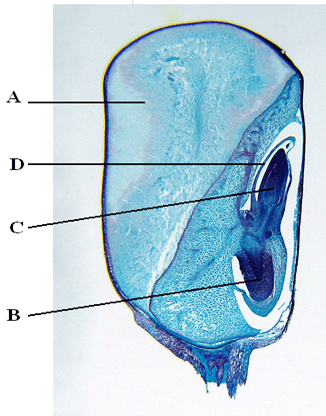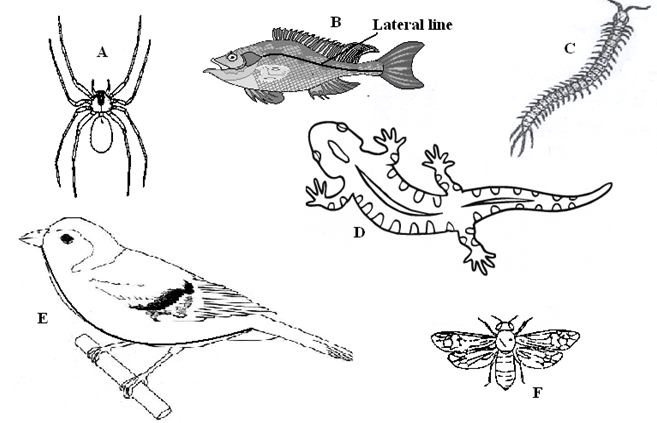INSTRUCTIONS TO CANDIDATES
- Write your name and Index Number in the spaces provided above.
- Sign and write date of examination in the spaces provided above.
- Answer ALL questions in the spaces provided in the question paper.
- You are NOT allowed to start working with the apparatus for the first 15 minutes of the 13/4 hours allowed for this paper. This time is to enable you to read the question paper and make sure you have all the chemicals and apparatus that you may need.
- All workings MUST be clearly shown where necessary.
- Mathematical tables and silent electronic calculators may be used.
- You are provided with a solution L. Using the reagents provided; determine the food compounds in L.
- Fill in the table below.
FOOD COMPOUND PROCEDURE OBSERVATION CONCLUSION - Place 10mls of solution L in a visking tubing. Tie both ends and place it in 50mls of distilled water contained in a beaker.leave the set up for 20 minutes and make observations.
- Observations. (1mark)
……………………………………………………………………………………………………………………………………………………………………………………………………………………………… - Account for the observation in b (i) above. (2marks)
……………………………………………………………………………………………………………………………………………………………………………………………………………………………………………………………………………………………………………………………………………… - Give the equivalent of a visking in the bodies of living organisms. (1mark)
………………………………………………………………………………………………………………………………………………………………………………………………………………………………
- Observations. (1mark)
- Fill in the table below.
- Study the photomicrograph of the longitudinal section of a maize fruit below and answer the questions that follow

-
- Name the parts labelled A, B, C and D. (4marks)
A
…………………………………………………………….
B
…………………………………………………………….
C
…………………………………………………………….
D
……………………………………………………………. - Give the role played by A and D. (2 mark)
A
………………………………………………………………………………………………………………………………………………………………………………………………………………..….
D
……………………………………………………………………………………………………………………………………………………………………………………………………………………
- Name the parts labelled A, B, C and D. (4marks)
-
- Name the type of germination exhibited by maize grain. ( 1 mark)
…………………………………………………………………………………………………………………………………………………………………………………………………………………… - Place the organisms from where the photomicrograph was obtained into its
Kingdom
Division
Class (3marks) - State three characteristics of members of the class identified in b (ii) above (3marks)
…………………………………………………………………………………………………………………………………………………………………………………………………………………………………………………………………………………………………………………………………………………………………………………………………………………………………………
- Name the type of germination exhibited by maize grain. ( 1 mark)
- Give one reason why the maize grain is classified as a fruit. (1mark)
………………………………………………………………………………………………………………………………………………………………………………………………………………………………………………………………………………………………………………………………
-
- Study the organisms drawn below and answer the questions that follow

- Use the dichotomous key below to identify the class the organisms belong to. (12 marks)
-
- Phylum Chordata ……………………………………………………… go to 2
- Phylum arthropoda ……………………………………………………. go to 3
-
- Has scales on the body ………………………………………………… go to 4
- Has no scales on the body …………………………………………..… Mammalia
-
- Has cephalothorax ……………………………………………….……. Arachnida
- Has no cephalothorax …………………………………………………. go to 5
-
- Has fins ………………………………………………………………… Pisces
- Has no fins ……………………………………………………………... go to 7
-
- Has three pairs of legs …………………………………………………. Insecta
- Has more than three pairs of legs ……………………………………… go to 6
-
- Two pairs of legs per segment ………………………………………… Diplopoda
- One pairs of legs per segment …………………………………………. Chilopoda
-
- Has feathers ……………………………………………………………. Aves
- Has no feathers ………………………………………………………… go to 8
-
- Has a tail ……………………………………………………………….. Reptilia
- Has no tail …………………………………………………………….. Amphibia
Specimen Step followed Identity A B C D E F
-
- If the actual length from the tip of the mouth to the tip of the tail of the specimen B is 100mm, calculate the magnification. (2marks)…………………………………………………………………………………………………………………………………………………………………………………………………………………………………………………………………………………………………………………………………………………………………………………………………………………………………………
- Use the dichotomous key below to identify the class the organisms belong to. (12 marks)
CONFIDENTIAL INSTRUCTIONS
These instructions are to enable the Head of Institution and the teacher in charge of Biology to make adequate preparations for 231/3 Biology Practical.
No one else should have access to this information either directly or indirectly.
Each candidate requires the following
- 20mls of solution L
- 4 test tubes in a test tube rack.
- Benedict’s solution
- Iodine solution
- 1% copper sulphate
- Sodium hydroxide (10%)
- DCPIP
- Source of heat/water bath
- Test tube holder
- Visking tubing 8 cm long
- Thread/string 2 pieces 10cm long each.
- 50 mls beaker
- Distilled water
- 10mls measuring cylinder
NB Solution L contains glucose and ascorbic acid dissolved in water









MARKING SCHEME
-
-
FOOD COMPOUND PROCEDURE OBSERVATION CONCLUSION Starch To 2cm3 of solution L add drops of iodine√1mk Colour turns brown /yellow√½ mk Starch absent½ mk Reducing sugar To 2cm3 of solution L ,add benedicts solution and boil√1 mark Colour changes from blue to green to yellow/orange√½ mk Reducing sugars present½ mk proteins To 2cm3 of solution L add 3 drops of NaOH followed by drops of CuSO4 and shake√1mk solution remains blue√½ mk Protein absent½ mk Ascorbic acid (vitamin c) To 2cm3 of solution DCPIP add solution L dropwise shaking till in excess √1mk DCPIP decolourised√½ mk Vitamin C /Ascorbic acid present ½ mk -
- solution in the visking tubing increases in volume
- Water moves by osmosis; in the visking tubing due to the high osmotic pressure of the solution in the visking tubing
- Cell membrane/plasma membrane/plasmalema
-
-
-
-
- Endosperm
- – Radicle
- – Plumule
- – Plumule sheath/coleoptile
- A – stores food for the embryo;
D – protects the delicate plumule from mechanical damage;
-
-
- hypogeal;
- Kingdom – Plantae; Rej plant
Division – spermatophyte
Class –Monocotyledonae; rej monocot/monocotyledon - Fibrousroots
Parallelvenation;
Floral parts occur in three /multiples of three;
Sheath like petiole; Mark first three
- Has two scars;
-
-
Specimen steps identity A 1b,3a; Arachnida B 1a,2a,4a; Pisces C 1b,2b,5b,6b; Chilopoda D 1a,2a,4b,7b,8a Reptilia E 1a,2a,4b,7a; Aves F 1b,3b,5a; Insecta -
Magnification = Diagram length = 50mm
Actual length 100mm;
= X½ or X 0.5;
Download Biology Paper 3 Kenya High Post Mock Exams 2020 with Confidentials - Questions and Answers.
Tap Here to Download for 50/-
Get on WhatsApp for 50/-
Why download?
- ✔ To read offline at any time.
- ✔ To Print at your convenience
- ✔ Share Easily with Friends / Students

